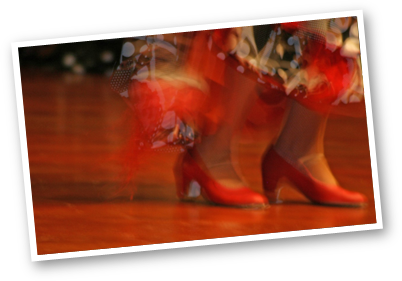"It doesn't matter if you're 18 or 80. If you can stand, you can do it."
"My students claim it makes them happy when they dance," says Rosario Ancer, who started her Centro Flamenco school in Vancouver in 1989. "Flamenco absorbs you emotionally and physically, so you release your worries."
The dance form has become so popular on the West Coast that Vancouver has hosted a Flamenco Festival every June since 1990. Ancer says she working on attracting flamenco troupes from across Canada for this year's event starting June 26th.
Esmeralda Enrique has taught flamenco in Toronto since 1981. Like Ancer, her classes have ballooned from a handful to more than 200 every year.
"It's like I'm welcoming them to my house: 'Come on in, there's a party here and good food and wine.'"
The dance sprouted from the Andalusian region of Spain where the Moors, gypsies and local culture intermingled during the 16th century. The Gypsies adopted it as their dance and performed it in "café cantantes."
Flamenco involves singing (cante), dancing (baile) and the guitar (la toque). The music is punctuated by "palmas" or hand clapping and sometimes, castanets. The dancer interprets the words of the singer through percussive foot-stomping and hand and body movements. Men and women can dance it alone, with a partner or in a group.
"I like the passion, the force of it," says Alpana Garg, a 33-year-old professional in Toronto who started courses last fall. "When you dance it, you are dancing for yourself."
Enrique and Ancer say they've seen a steady increase in flamenco in the past five years. They think it may be due to the increasing popularity of Latino culture.
"After my first few lessons, I thought, 'why didn't I start this sooner?'" says Lisa Nabieszko, 40, the owner of an arts administration business.
"It doesn't matter if you're 18 or 80. If you can stand, you can do it."
Many beginner students go to their classes dressed in loose clothing, perhaps wearing a full skirt and sturdy, wide-heeled shoes. Beginners aren't required to have flamenco shoes, which have dozens of nails hammered into the heel and toe, and can be bought at dance studios for $120. Seamstresses can put together a flamenco skirt for $75 plus the cost of materials.
"There is no syllabus for flamenco. That would be a contradiction of the dance," says Ancer.
While there is no world or national flamenco body of authority, you can ask the teacher how long she has practised the craft. At least five years of dancing would be a good start and also, if she's studied in Spain or Latin America.
"I introduce them to the culture, not just the steps," says Margarita Montaner, who has taught castanets and flamenco in Red Deer and Calgary. She now teaches introductory classes at the Banff Centre.
"I suck at it," admits Nabieszko with a loud laugh. She has taken classes, on and off, since 1994. "But when I do it, I feel powerful: 'Don't mess with me -- I'm a flamenco dancer.'"
Nabieszko says it's one thing to learn technique, but good teachers will imbue students with the "feel" of the dance. Enrique compares flamenco to "eating from a bowl of emotion."
"I get aroused," says Elena Louch, 46, a computer teacher in Toronto. "I'm in command of my body, so I feel sexy and strong."
Professional dancers study their craft throughout their lives. Enrique has performed for almost 40 years, starting at the age of eight in San Antonio, Texas. Ancer has been dancing professionally for 24 years. Montaner has taught for more than 15 years. She is also a certified fitness instructor and says flamenco can provide anywhere from a low to high aerobic workout, depending on the steps.
"Once you try it, you're hooked," she says. "It's because flamenco is an expression that comes from the inside." Nabieszko adds flamenco clears the mind of clutter.
"You're concentrating on the arc of your arm as it passes your face so you forget about the meeting yesterday when you got chewed out." Enrique says many people can do it into their old age.
"When I dance it I feel life to the fullest."
Are you ready for flamenco? then, baile! Baile!
